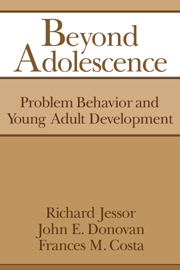10 - Problem behavior and young adulthood: Continuities in change
Published online by Cambridge University Press: 07 October 2009
Summary
The primary aim of renewing and extending our longitudinal study of youth was to add to knowledge about psychosocial development beyond adolescence and, at the same time, to explore a portion of the life course – young adulthood – that was still largely uncharted. The research findings in the preceding chapters represent what we have been able to accomplish in pursuing that aim. Their significance, and the conclusions they support, are elaborated in this final chapter.
The approach that was taken was guided by a conceptual framework – Problem-Behavior Theory – that had proved useful earlier in achieving an understanding of problem behavior and psychosocial development in adolescence and youth. Whether its explanatory reach would include young adulthood as well was yet to be determined. Nevertheless, the domains of inquiry that were engaged – personality, the perceived environment, the social environment, behavior – and the key concepts that were measured – values, expectations, social and self attitudes, models for behavior – all derived from that theoretical perspective. The major theoretical formulation about the likelihood of occurrence of problem behavior was also retained: Psychosocial proneness to problem behavior in young adulthood was considered to be a resultant, reflecting the balance of instigations and controls in the various explanatory systems. And the theoretical position about psychosocial development as the outcome of person–environment interactions over time continued to shape the study and interpretation of developmental change.
- Type
- Chapter
- Information
- Beyond AdolescenceProblem Behaviour and Young Adult Development, pp. 273 - 296Publisher: Cambridge University PressPrint publication year: 1992



